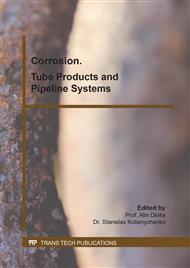p.1002
p.1008
p.1014
p.1019
p.1025
p.1031
p.1036
p.1043
p.1049
Effect of Layer-by-Layer Texture Inhomogeneity on the Stress Corrosion of Gas Steel Tubes
Abstract:
Based on the data of X-ray texture and structure analysis of the material of main gas pipelines it was shown that the layerwise inhomogeneity of tubes is formed during their manufacturing. The layerwise texture inhomogeneity of steel tubes, obtained by hot rolling at the air, differs depending on variation of technological parameters of their processing in inner and outer layers, i.e. the temperature and deformation gradients, penetration of interstitial impurities into the surface layer from surrounding atmosphere etc. The thickness of the surface layer with modified texture parameters depends on the temperature of rolling and its regime. Under exploitation when stress-corrosion cracks grows and reach the layer with a modified texture, their opening is slowing down or stops because of the high mutual misorientation of grains of different layers and the necessity of changing the plane of moving cracks, what requires additional tensile stresses. Layered textures of different gas tubes were compared. It was shown that character and degree of arising inhomogeneity correlates with the tubes resistance to stress-corrosion cracking.
Info:
Periodical:
Pages:
1025-1030
Citation:
Online since:
November 2016
Price:
Сopyright:
© 2017 Trans Tech Publications Ltd. All Rights Reserved
Share:
Citation:



